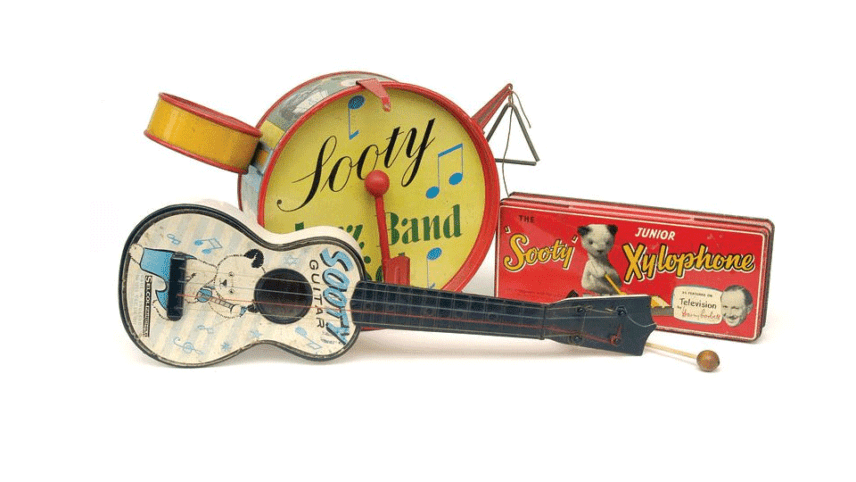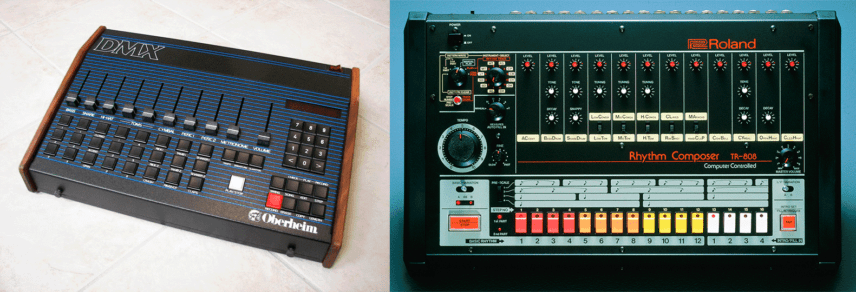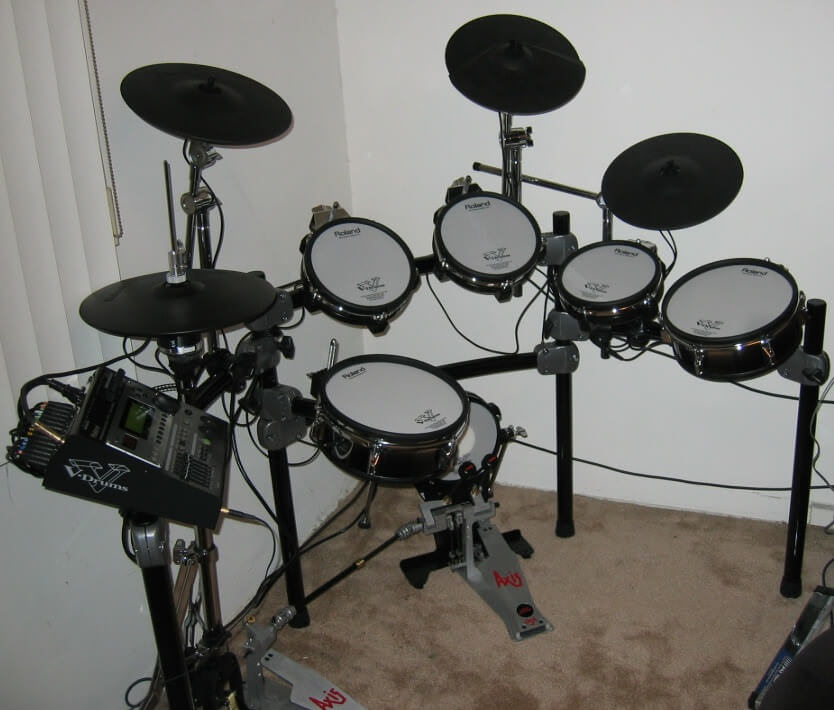‘Before you could quantise things we’d sample every drum and reprogram the whole backing track out of these parts. I basically turned myself into a drum machine’. Well known for combining drum machines with traditional drumming, Stephen Morris, drummer for New Order and previously Joy Division, talks us through his career in gear.
Chad Valley Sooty drum kit

Sooty Three Musical Instruments 1950s-60s. V
Technically, before I saw Hawkwind, my first gig was Sooty at the boys’ club in Macclesfield, getting the Sooty xylophone at the merch stall and then being given the drum kit for Christmas. Almost immediately it was, “What have we got him that for? Take it off him!” because of the noise.
The guy in [1977 Manchester punks] the Worst had the same Chad Valley Sooty drum kit, but I always found drum kits mysterious. What’s the big round thing in front? Is he kicking it? With guitarists, you could see what they were doing. With drummers, there was always that element of a magician who’d saw somebody’s leg in half.
My first proper kit was an Olympic, Premier’s budget line. I’ve still got one tom tom from it, which I used all the way through Joy Division. I collected drums, so by Unknown Pleasures ended up with a Hayman bass drum, the best thing ever, Premier toms and a not bad Premier snare drum.
I got pissed one Saturday and put a fiver on it this secondhand shop in Macc and then forgot all about it. The guy rang up. “Are you gonna pay for this or what? Bloody drummers!” Then I added the synth drum. Hang on, I’ll go and get it… [Returns slightly breathless and plonks a flyer saucer device on the sofa]. “And this was used on [Joy Division’s] She’s Lost Control
Synare 3 synth drum
Getting into electronics was a mistake. I’d seen Kraftwerk on telly but mostly it was from the cover of Can’s Tago Mago. Jaki Liebezeit was and is my favourite drummer and had this gadget that looked like a drum synthesiser, then I saw the Synare PS-1 in a music shop window one Sunday afternoon. [Fetches it]. It’s got a handle, like a suitcase and you hit it with sticks. I never used it, but then I got the smaller one [the Synare 3] made the same company.
This is on She’s Lost Control, Disorder and Insight – the bit that sounds like a flock of pigeons. You had to twiddle the knobs and hit it at the same time, so a few of the knobs got broken off.
Gretsch and Rogers drumkits
When Joy Division made Closer, I had a Black Rogers kit, and then by New Order in 1981 I had a brown Gretsch.
The Rogers got nicked in America but I got in back, but in the meantime, I was persuaded to buy a Gretsch kit which I didn’t really like or want. I wanted a black one and ended up with a mahogany. [Producer] Martin Hannett used to put gaffa tape and bog roll all over it, then totally disassembled to satisfy his lust for perfect sound, recording each drum individually with me playing on my soon to be very bruised leg with the other hand to keep time.
My left leg’s still fucked now. On [New Order’s] Movement, he took every single screw out of it and then decided that the springs inside the tuning bolts were making a noise. We had to take every spring out and replace them all with kitchen roll. The side effect was that we could never tune it.
Roland CR-78 CompuRhythm drum machine
This was on OMD’s Enola Gay, Blondie’s Heart Of Glass and a lot of things in the late 1970s. Martin didn’t like the Synare so for Decades [on Closer] he told me to get a drum machine. It sounded great but I was sat there with the bloody Roland manual trying to programme it. It said ‘requires accessory X’, so we’d get this extra bit. It drove me potty.
The manual didn’t make any sense and then even when you got the fucking extra pedal programming it still didn’t work. We accidentally discovered how to do Temptation, but that’s another story. I gave up on it and for years afterwards, I thought computers were complete shit. Then I realised there are two different pedals you can get for it, one for programming and one was the start-stop thing, and I’d got the start-stop thing! When we did the first New Order album, Movement, Martin got us a deal on a little battery operated Dr. Rhythm which was easy to programme because it only had two buttons. So we did the song Truth on that.
Oberheim DMX & TR-808 drum machines

There’s a story that I forgot the drumbeat to Blue Monday and had a to reprogram it in the Oberheim, and came up with a different beat. It’s a good story that makes the drummer look like the comedy item – “Don’t let him near it!” but not true. I can remember things.
The other story is that I pulled the lead out with my big feet. That came about because Terry [Mason, roadie] brought a lead that was a foot long so I had to program it on the floor. When we recorded Confusion in New York we turned up at [producer] Arthur Baker’s place with no gear. “Got any ideas then?” “I thought you’d have some.” So we had to use what was there, which basically was Arthur’s 808 which had all Afrika Bambaataa’s stuff and Freez’s IOU on it. There was one memory location and it was all – “Oh don’t touch that.”
E-mu Emulator sampling synthesiser

We’d done sampling in Joy Division, even though it wasn’t called that then. Martin had this AMS delay box which had a sample function, so you could record a sound and it would stay in there like a bee in the box.
In 1979 the Fairlight CMI came out. Martin wanted one but Tony [Wilson, Factory Records boss] wanted to build the Hacienda club and Fairlights were ridiculously expensive. The Emulator came out and couldn’t do half the things you could do with the Fairlight but you could record a sound and play it back.
When we first got it we recorded fart noises on it and played choruses of farts. “Listen to this, it’s fucking brilliant!”’ The Emulator did the voices for Blue Monday and the frog choruses on The Perfect Kiss. We got a whole family of them in the end.
E-mu Drumulator Mk.I
Technique was an interesting album because we’d moved on to Voyetras (fetches one), a rack-mounted synth. Midi came out so you could plug a keyboard into it.
Earlier, when we did with [producer] Stephen Hague to do True Faith he had a Drumulator Mk.1 which was a drum version of the Emulator, so it had compression on it. On the record it’s a drum machine and live I play a sample. It turned into the E-mu SP 12, which was the sampling drum machine that launched hip-hop. By the time we got to Technique we were still using those synths but we’d moved on to Akai samplers, loads of them.
So we had a Mac running Upbeat software, a simple drum machine and all these Akais. A lot of the things on Technique that sound natural are not. For Dream Attack, we were too lazy to play an acoustic guitar, so we sampled every note in the riff and programmed them individually. It was bonkers, one sampler per string!
Oh and before you could quantise things we’d sample every drum and reprogram the whole backing track out of these parts. I basically turned myself into a drum machine. When we did Technique it felt new and pioneering, but then everybody started doing it.
Roland V-Drums

The wilderness years. V-Drums [electronic drums] seemed like a good idea at the time. I’ve got tinnitus so I thought it would be much better than being in the room with a real drum kit, and also better for the neighbors. Fucking hell. It was like playing treacle. You just want to hit them harder and it makes no difference to the sound. I mean, never let it be said I’m impatient.
I stuck with them for a number of years and a number of models. I’m not knocking V-Drums because they’re a really good way of getting people to play drums, but there were loads of leads and everything and it was really messy. Live I could barely hear myself at all. You’d hit the cymbal and not hear it so I’d mix it live and then no matter how hard you hit it, it was like a dinner gong. “Banggg!!!”
In the end they had to go, so now I’m back to normal drums but using triggers, so you get an acoustic response but a sample to fill it out. Best of both worlds? Well, It works for me.
Stephen Morris’s memoir, Record Play Pause, Confessions of a Post-Punk Percussionist: Volume 1 is published on May 16 by Little Brown. You can check it out here.
Dave Simpson is a music journalist, author of the book The Fallen (about The Fall) and very amateur drummer. Follow him on Twitter.
